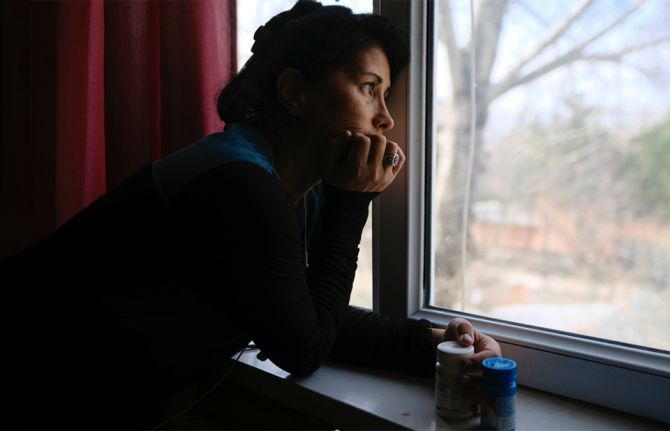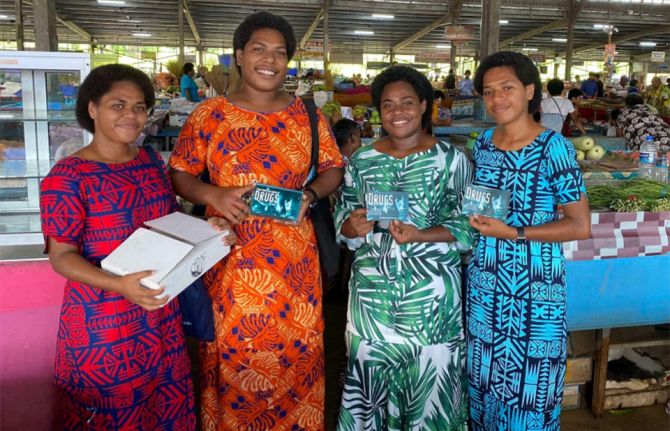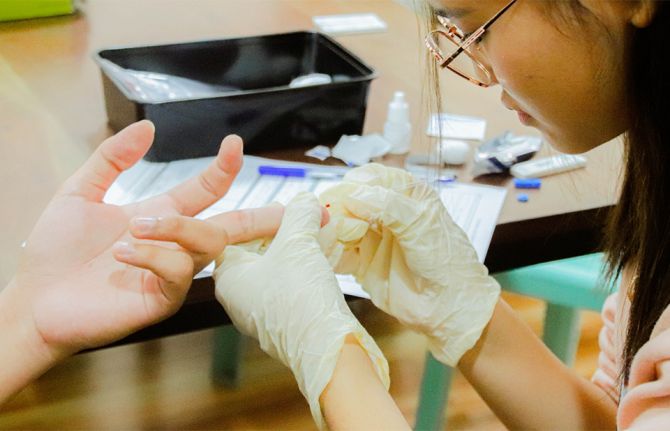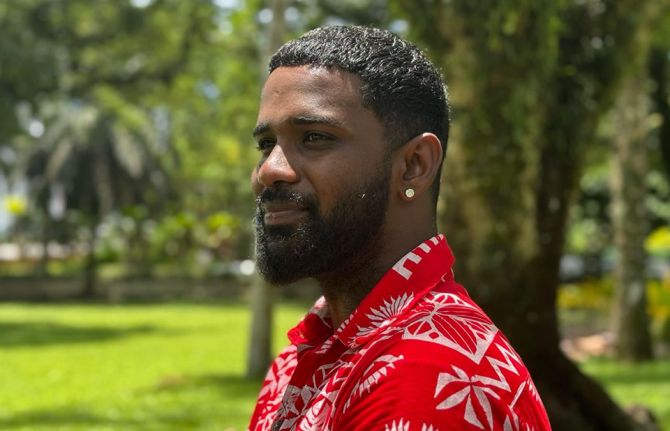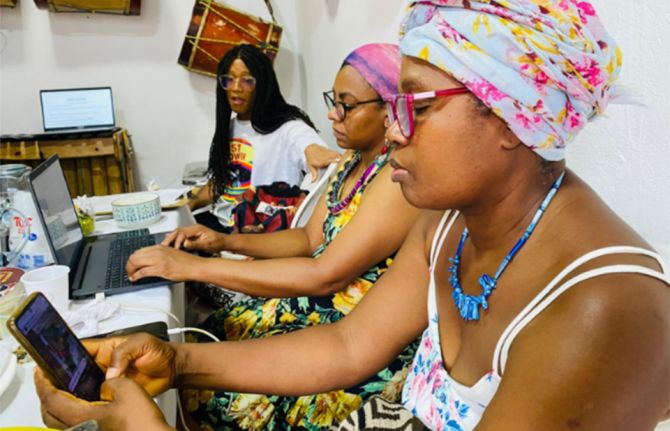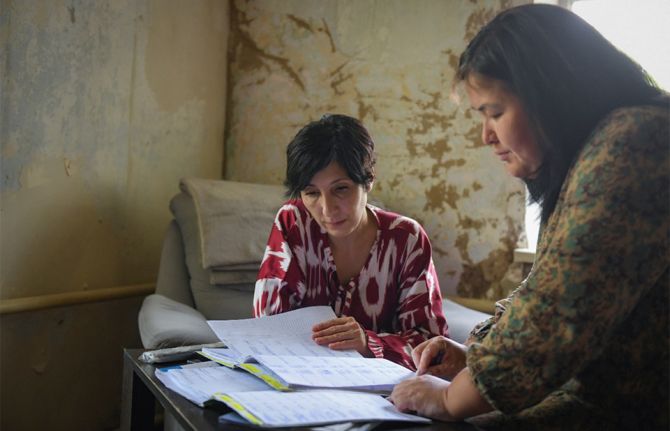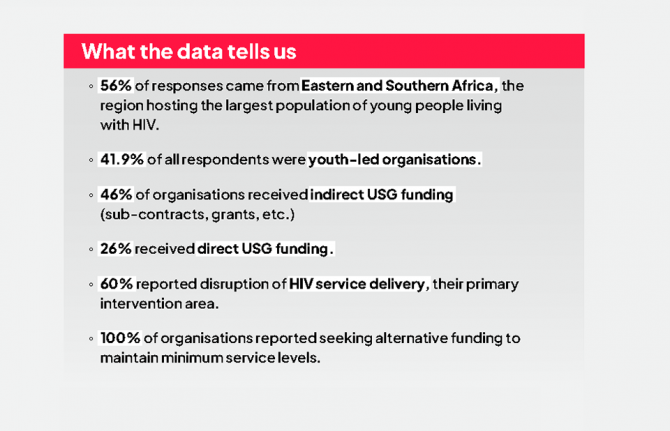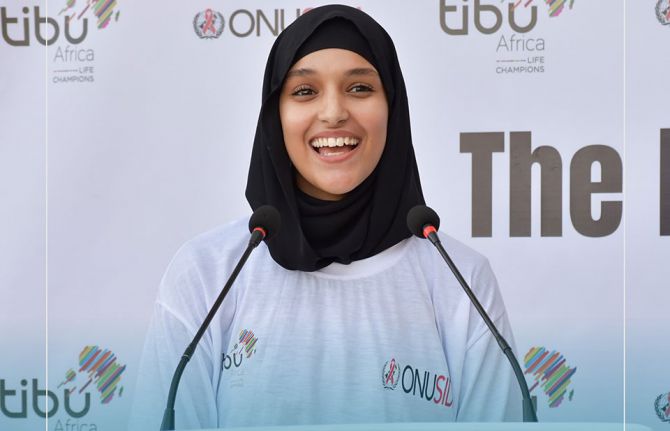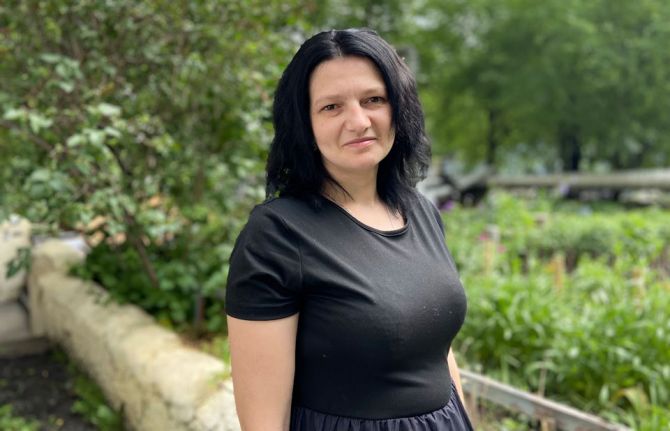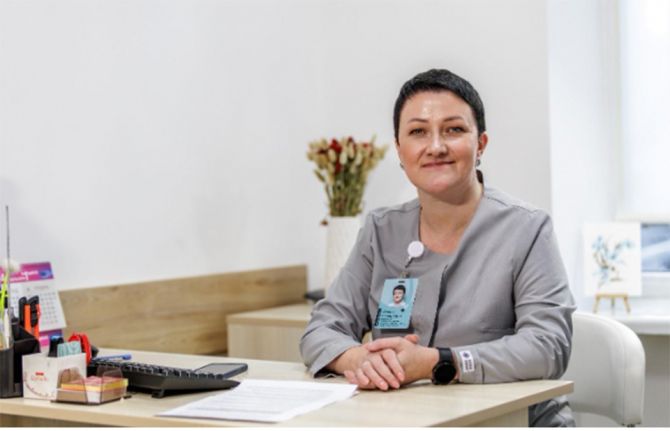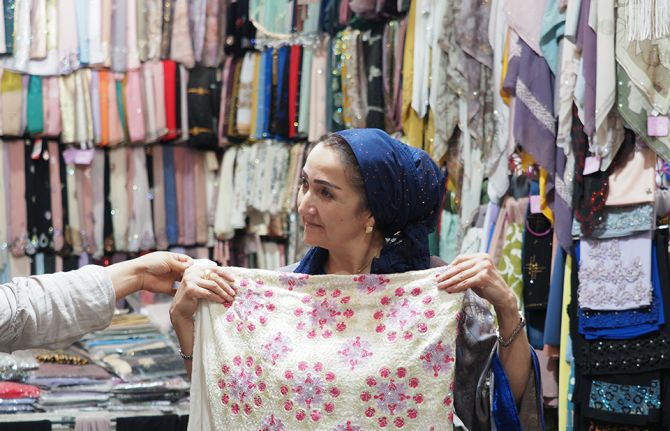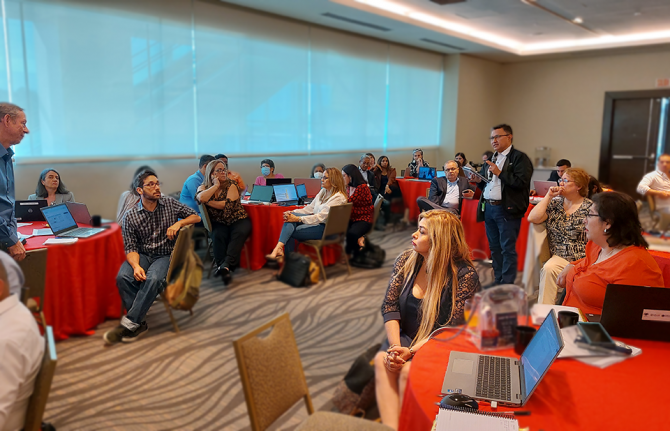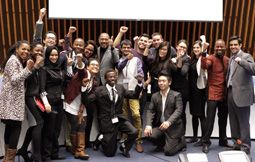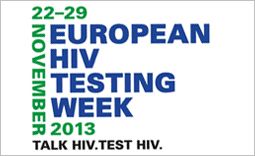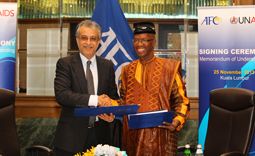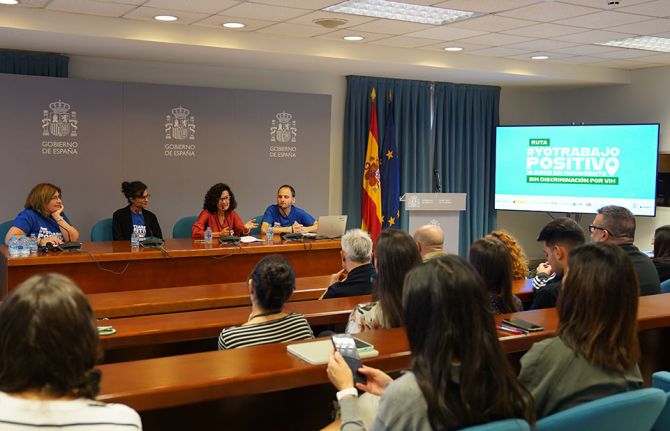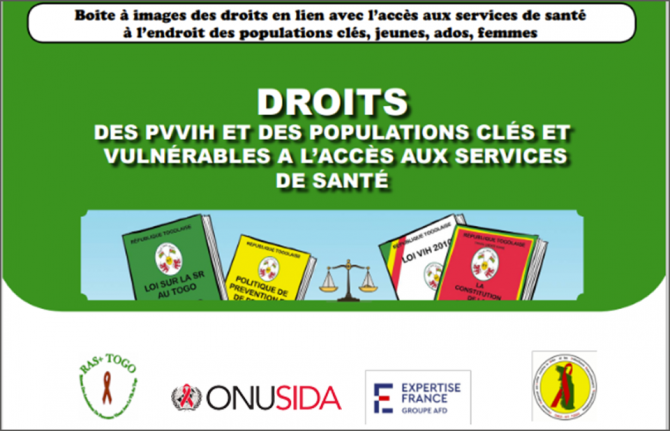
Feature Story
Getting to Zero new HIV infections: High Level Meeting panel outlines way forward
08 June 2011
08 June 2011 08 June 2011
Ms Mari-Josee Jacobs, Minister or Cooperation and Humanitarian Affairs, Luxemburg, Moderator Ms Kgomotso Matsunzane, Dr Jarbas Barbosa, Deputy Minister of Health of Brazil, Helen Clark, United Nations Development Programme, and Jaevion Nelson, youth activist from Jamaica.
Photo : Photo ONU/Eskinder Debebe
Global rates of new HIV infections have steadily declined over the past years, with the annual rate falling by nearly 25% between 2001 and 2009. But with 7 000 new HIV infections daily, the rate of people becoming newly infected still outpaces the capacity to extend treatment access and cope with the effects of HIV.
As part of the United Nations General Assembly High Level Meeting on AIDS, a panel entitled Prevention—what can be done to get to Zero new infections? chaired by Ms Mari-Josee Jacobs, Minister or Cooperation and Humanitarian Affairs, Luxemburg, brought together the Administrator of the United Nations Development Programme (UNDP), Helen Clark, Jaevion Nelson, youth activist from Jamaica, and Dr Jarbas Barbosa, Deputy Minister of Health of Brazil engaged with the audience in an inspired and interactive session on how to amplify and sustain the momentum of this HIV prevention revolution.
Setting the scene, Ms Jacobs opened with stressing the importance on involving people living with HIV in all aspects of HIV prevention programming: “It is important to engage people living with HIV—and especially young people living with HIV—in HIV prevention efforts to improve programmes with full respect for human rights to all.”
Moderated by South African TV personality Kgomotso Matsunzane, the discussion centred around key questions such as ‘What stands in the way of getting to zero new infections?’ and ‘How are rights integral to prevention?’
We need address the punitive laws that act as barriers to HIV prevention. The law can stand in the way or promote effective responses—we must create an enabling legal environment for HIV prevention.
Helen Clark, Administrator of the United Nations Development Programme
“With this High Level Meeting we have a unique opportunity,” said Dr Barbosa as he opened the panel discussion. “We cannot wait for another 30 years to eliminate HIV. We need a strong declaration from this High Level Meeting that represents the political commitment, and that moves the agenda forward.”
According to the most recent population-based surveys in low- and middle-income countries, only 24% of young women and 36% of young men responded correctly when asked five questions on HIV prevention as well as misconceptions about HIV transmission. And while global new HIV infections are decreasing, Eastern Europe and Central Asia is the only region in the world where new HIV infections are increasing.
In her opening address Ms Helen Clark, UNDP Administrator noted that there is a need to confront the social, sexual and gender norms that drive vulnerability to HIV.
“Legal frameworks need to accommodate effective responses to HIV. So often the law stands in the way of reducing risk and vulnerability, and of spreading access to treatment and prevention services. Where human rights are not upheld, genuine universal access to services is impossible,” said Ms Clarke.
Jaevion Nelson, youth activist from Jamaica, agreed: “Far too many programmes are failing because they are not based on the evidence that exists. We must all: as governments, as civil society and the international community do the right thing.”
HIV prevention investments only represent about 22% of all HIV spending in 106 low- and middle-income countries. Clearly much remains to be achieved to ensure that the vision of zero new HIV infections is reached.
In an impassioned intervention from the floor, Dr Nafsiah Mboy Executive Director of the Indonesian National AIDS Commission urged the panellists to remember to address a group who are commonly not considered most at risk, but indeed are—the ‘4 M’s’ as she called them—mobile men with money in a ‘macho’ environment. “Let us turn these men into responsible men. That way we will have zero new infections among our women and zero new infections among our children,” said Dr Mboy.
Far too many programmes are failing because they are not based on the evidence that exists. We must all as governments, as civil society and the international community to do the right thing.
Jaevion Nelson, the youth activist from Jamaica
It was also agreed in the discussion that rapid access to both future and existing HIV prevention tools—including male and female condoms, male circumcision, the elimination of vertical transmission and treatment for prevention—is needed. The last point inspired by the recent announcements of the HPTN 052 study which showed that if an HIV-positive person adheres to an effective antiretroviral therapy regimen, the risk of transmitting the virus to their uninfected sexual partner can be reduced by 96%.
UNAIDS strategy 2011 – 2015: Getting to Zero outlines the bold goals for 2015: 1) sexual transmission of HIV reduced by half, including among young people, men who have sex with men and transmission in the context of sex work; 2) Vertical transmission of HIV eliminated and AIDS-related maternal mortality reduced by half; and 3) all new HIV infections prevented among people who use drugs. This is part of UNAIDS vision to reach zero new HIV infections.
UN General Assembly High Level Meeting on AIDS
Thirty years into the AIDS epidemic, and 10 years since the landmark UN General Assembly Special Session on HIV/AIDS, the world has come together to review progress and chart the future course of the global AIDS response at the 2011 UN General Assembly High Level Meeting on AIDS from 8–10 June 2011 in New York. Member States are expected to adopt a new Declaration that will reaffirm current commitments and commit to actions to guide and sustain the global AIDS response.
External Links
External Links
Multimedia
Multimedia
Publications
Publications
Related
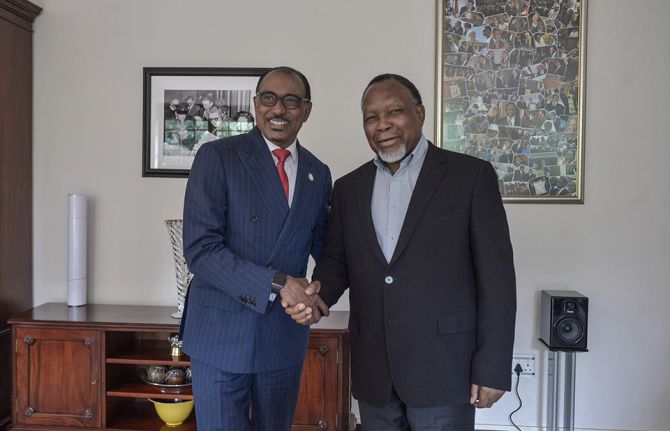 Keeping up the momentum in the global AIDS response
Keeping up the momentum in the global AIDS response

24 April 2019
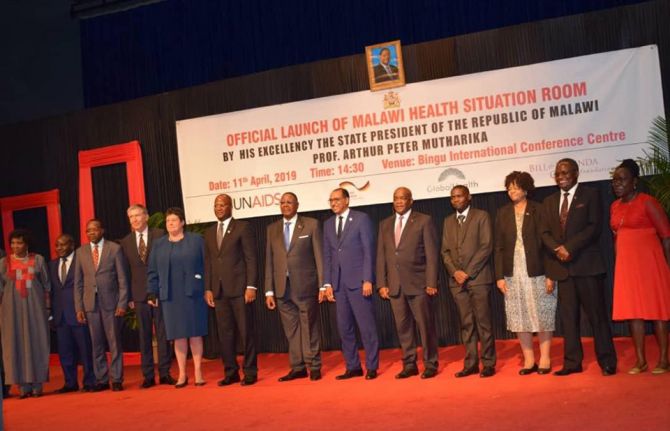 Malawi launches its health situation room
Malawi launches its health situation room

12 April 2019
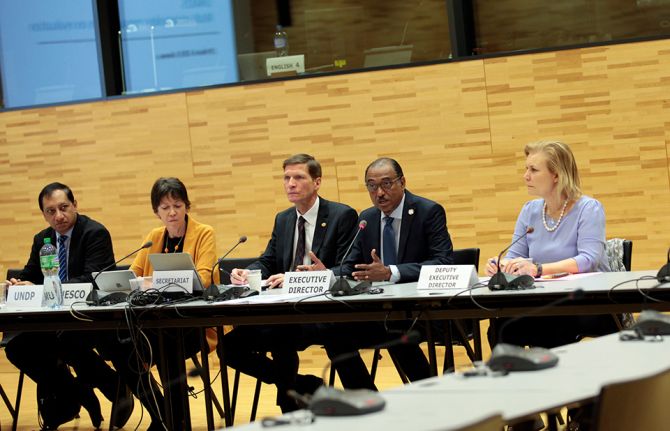 Learning lessons on evaluation
Learning lessons on evaluation

02 April 2019

Feature Story
Harnessing the power and leadership of parliamentarians in the AIDS response
07 June 2011
07 June 2011 07 June 2011
(Left to Right): Michel Sidibé, Executive Director of UNAIDS; Anders Johnsson, Secretary General of the IPU; at Parliamentarians Meeting on June 7, 2011, at UN Headquarters, NYC.
Credit: UNAIDS/B. Hamilton
The world’s parliamentarians have a crucial role to play in an effective response to the AIDS epidemic. They provide leadership, help set the national agenda, formulate laws and authorize AIDS spending. How this influence can be harnessed in the challenge to HIV was the central theme of an important meeting for parliamentarians held on the eve of the UN High Level Meeting on AIDS in New York.
Co-organized by the Inter-Parliamentary Union (IPU), the United Nations Development Programme (UNDP) and UNAIDS, the forum was attended by a number of members of parliament and several ministers taking part in the High Level Meeting.
It explored a range of issues, including the impact of law on HIV interventions and how legislation can be used to reinforce, rather than hinder, public health and development responses. These were seen through the prism of three key themes: universal access to HIV prevention, treatment, care and support; protection and promotion of rights of people living with HIV, and those most vulnerable to HIV, and discriminatory and punitive laws which are compromising AIDS investments.
The gathering also examined the underlying politics of the new global consensus on HIV and looked at the main outcomes likely to emerge from the High Level Meeting. The emphasis throughout was firmly on concrete and practical action and translating AIDS commitments into reality, using the full range of parliamentarians’ authority in the spheres of leadership, budget allocation and law making and reform.
Nonviolence is the only way to create social change. And you are the ones who have been chosen to lead that change
UNAIDS Executive Director, Michel Sidibé
In opening remarks Anders B. Johnsson, IPU Secretary General, said the role of members of parliament in the global response to HIV could not be underestimated: “We have entered a new era in the AIDS response where parliamentarians need to work in strategic partnership with UNAIDS and to pay greater attention to shared responsibility and mutual accountability.”
UNAIDS Executive Director, Michel Sidibé made a powerful call for leadership from the parliamentarians: “Violence is a cancer, a gangrene growing inside of us. We may not see it but it is there. It undermines our foundation. It undermines what our ancestors wanted for us. Nonviolence is the only way to create social change. And you are the ones who have been chosen to lead that change.”
Other participants at the meeting included Representative Jim McDermott, US Congress; Petra Bayr, member of the Austrian Parliament; Christoph Benn, the Global Fund’s Director of External Relations and Partnerships; and the Hon Michael Kirby, Judge of the High Court of Australia (retired) and Commissioner of the Global Commission on HIV and the Law.
The need for parliamentarians to effectively deploy legislation as a tool for ensuring and sustaining universal access to HIV services was reinforced by Petra Bayr and Hon. Michael Kirby who said: “In the HIV response, the law is not serving those most vulnerable – sex workers, men who have sex with men, transgender people, injecting drug users. When parliamentarians make no mention of those most vulnerable to HIV – this means that these very populations are out of the reach of essential services and condemned to death. We are suffering from a new virus, ‘Legislative Silence Virus’. We must work together to prevent the spread of this new virus—that is what the Global Commission on HIV and the Law hopes to do.”
The meeting provided a valuable opportunity for the IPU to consolidate its plan of action in the coming years; HIV is a central strand in its new draft strategy, 2012-17. The organization’s commitment to challenging AIDS is long-standing and since 2006 there has been an IPU Advisory Group on HIV/AIDS.
This group focuses on providing members of parliament with access to relevant policy expertise and skills to properly exercise their duties of lawmaking, oversight, leadership and advocacy. It pays special attention to the objective of achieving universal access to HIV prevention, treatment, care and support services, and the protection and promotion of rights as a prerequisite for meeting the Millennium Development Goal 6 targets.
External links
Related

Feature Story
Japan hosts follow-up meeting to discuss outcomes of MDGs Summit 2010
03 June 2011
03 June 2011 03 June 2011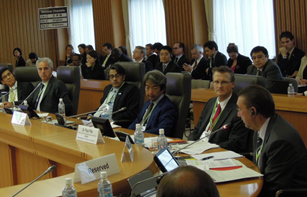
Dr Paul De Lay at the MDGs Follow-up Meeting
Credit: UNAIDS
The Government of Japan, along with the United Nations Development Programme (UNDP), the United Nations Children's Fund (UNICEF), the World Bank and the Japan International Cooperation Agency (JICA), convened a follow-up meeting on 2-3 June 2011 in Tokyo to discuss the outcomes of the UN Millennium Development Goals (MDGs) Summit that took place in September 2010.
With less than five years remaining before 2015, the target year for achieving the MDGs, the meeting brought together high level delegations from more than 100 countries and international organizations, and provided a unique opportunity to exchange knowledge, as well as to discuss more effective measures to strengthen coordination among a broad range of stakeholders.
The meeting was opened by H.E. Prime Minister Kan, who expressed deep appreciation for the solidarity shown by the international community in the wake of the unprecedented earthquakes and tsunami on 11 March 2011. Mr Kan also assured the audience that Japan remains committed to the achievement of MDGs.
Japan remains fully dedicated to carrying out faithfully the international commitments it has expressed in the past to achieving the MDGs
H.E. Mr. Takeaki Matsumoto, Minister of Foreign Affairs of Japan
Mr Takeaki Matsumoto, Japan’s Minister of Foreign Affairs, underlined this commitment saying, “Japan remains fully dedicated to carrying out faithfully the international commitments it has expressed in the past to achieving the MDGs.”
UNAIDS Deputy Executive Director, Programme, Paul De Lay took part in the meeting and also participated in one of the several side events, titled Preparing the health systems for the challenges beyond MDGs.
“UNAIDS has called for taking HIV out of isolation. At the High Level Meeting on AIDS next week, one of the major themes will be “integration”, including exploring synergies between HIV programmes and preventing and caring for non-communicable diseases,” said Dr De Lay.
UNAIDS has called for taking HIV out of isolation. At the High Level Meeting on AIDS next week, one of the major themes will be “integration”, including exploring synergies between HIV programmes and preventing and caring for non-communicable diseases
UNAIDS Deputy Executive Director, Programme, Paul De Lay
The event, moderated by Dr Suwit Wibulpolprasert, Senior Advisor on Disease Control, Ministry of Public Health, Thailand, included presentations from Michel D. Kazatchkine, Executive Director, The Global Fund to Fight AIDS, Tuberculosis and Malaria; Dr Mickey Chopra, Chief, Health Section, Program Division, UNICEF; and Dr Kenji Shibuya, Professor and Chair, Department of Global Health Policy Graduate School of Medicine, The University of Tokyo.
Coming just days before the UN High Level Meeting on AIDS in New York, the meeting enabled participants to exchange their good practices and also learn from others about projects and programmes focused on hard-to-reach regions and groups. Participants also discussed the “way forward” beyond 2015, using lessons learned in the decade under the current MDGs.
During his visit to Japan Dr De Lay also met with Dr Masato Mugitani, Assistant Minister for Global Health, the Ministry of Health, Labour and Welfare and Mr Masaya Fujiwara, Deputy Director-General for Global Issues of the International Cooperation Bureau, the Ministry of Foreign Affairs to discuss Japan’s active participation in the UN High Level Meeting, especially regarding prevention of mother-to-child transmission of HIV. Dr DeLay also met with civil society representatives who will attend the General Assembly event.

Feature Story
New monitoring centre helps tackle HIV in prisons in Latin America and the Caribbean
20 April 2011
20 April 2011 20 April 2011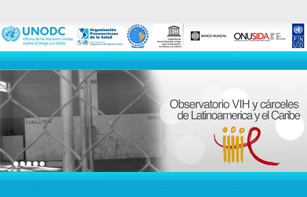
Observatorio VIH y Cárceles de LatinoaMÉrica y el Caribe
Mounting an effective challenge to HIV in prison settings is a key part of the AIDS response at national, regional and global levels. To define standards for HIV prevention and treatment and the protection and promotion of prisoners’ human rights, it is important to consolidate as much data as possible about the epidemic in this environment. The newly established Monitoring Centre for HIV and Prisons in Latin America and the Caribbean is set to become the key regional repository for such vital information.
The Monitoring Centre—called the Observatorio VIH y Cárceles de LatinoaMÉrica y el Caribe in Spanish—gathers data from 23 countries which is accessible via a web site. Its primary aim is to help governments and civil society define and implement national HIV prison policies based on international standards. Up and running in Spanish since mid-February, an English language version will be launched 30 April 2011.
The United Nations Office on Drugs and Crime (UNODC) is spearheading the initiative with support from the UN Educational, Scientific and Cultural Organisation (UNESCO), the Pan American Health Organization (PAHO), the World Bank, the UN Development Programme (UNDP) and UNAIDS.
According to José Vila del Castillo, UNODC Regional Advisor, “The Monitoring Centre shows the United Nations system ‘delivering as one’. Addressing HIV in the region’s prisons has become a priority. The centre is an important tool to catalyze prison reform processes and HIV penitentiary programmes.”
Addressing HIV in the region’s prisons has become a priority. The centre is an important tool to catalyze prison reform processes and HIV penitentiary programmes
José Vila del Castillo, UNODC Regional Advisor
Providing a permanent public space for informed reflection and dialogue, the virtual centre develops methodologies for collecting, processing, analysing and validating the scientific data gleaned on what works, and how best to proceed, in addressing HIV in prisons. It will highlight existing information and encourage ongoing research. Training and technical support are also offered through reference directories, online consultations, discussion forums and virtual classrooms.
In Latin America and the Caribbean, as elsewhere, many prisoners are vulnerable to HIV due to a number of factors, including the relative lack of knowledge about the virus among this population, overcrowding, lack of access to protection and good quality health services and violent conditions.
Across the region, where data are available, several countries have higher HIV prevalence in the prison population than in the general population. For example, according to data collected by UNODC this year, in Peru there are more than eight times as many people living with HIV in prison than outside (4.03% versus 0.4%). In Bolivia the situation is even starker; the same source documents show that in nine prisons in the country, 10% of prisoners are reported as HIV positive, compared to 0.2% prevalence in the wider society.
César Antonio Núñez, Director of UNAIDS’ Latin America Regional Support Team, believes the Monitoring Centre will provide a valuable insight into the lives of a neglected population, “The Centre will really help us to know the true HIV situation in the penitentiary system, and shed light on human rights-related issues. It is probably in the environment of HIV and prisons where UNAIDS’ commitment to being ‘the voice of the voiceless’ is most needed and appropriate.”

Feature Story
“Score the Goals” comic book launched: Ten football Goodwill Ambassadors embark on a journey facing the challenges of the Millennium Development Goals
26 January 2011
26 January 2011 26 January 2011
In the comic UNAIDS International Goodwill Ambassadors Michael Ballack and Emmanuel Adebayor talk about HIV
Credit: 'Score the Goals' An educational comic book about the MDGs
A new comic book for children featuring Michael Ballack and other football stars who are United Nations Goodwill Ambassadors was launched on 24 January at the United Nations in Geneva, Special Adviser to the UN Secretary-General on Sport for Development and Peace, Mr Wilfried Lemke.
“Score the Goals: Teaming Up to Achieve the Millennium Development Goals” is a 32-page educational comic book aimed at 8 to 12 year old children to provides a fun interactive way to help understand and reflect on the eight Millennium Development Goals.
The story features ten football United Nations Goodwill Ambassadors, including Michael Ballack, Emmanuel Adebayor, Roberto Baggio, Iker Casillas, Didier Drogba, Luis Figo, Raúl, Ronaldo, Patrick Vieira, and Zinédine Zidane.
The star-studded team journey to play an “all-star” charity football game in support of the United Nations. On the way they shipwreck on a deserted island and the story explores how the team copes by team spirit and survivor skills with the challenges that life on a deserted island brings.
The story simultaneously educates and entertains the young readers who are also invited to take action through several activities provided in the adjoining educational guide. The reader is invited to learn about the world’s challenges in ending hunger, universal education, gender equity, child health, maternal health, HIV, environmental sustainability, global partnership.
In 2000, the largest gathering of world leaders at United Nations Headquarters in New York adopted the United Nations Millennium Declaration. The Declaration, endorsed by 189 countries, committed nations to a new global partnership to reduce extreme poverty and it set out a series of targets to be reached by 2015. These have become known as the Millennium Development Goals (MDGs).
Everybody should have equal access to information and I hope that with this comic book we can reach out to a large young audience with important messages
Michael Ballack, UNAIDS Goodwill Ambassador and football star
In the comic Michael Ballack and fellow UNAIDS International Goodwill Ambassador Emmanuel Adebayor talk about HIV in reference to Goal 6 which sets out by 2015 to have halted and begun to reverse the spread of HIV.
Michael Ballack who has been a UNAIDS International Goodwill Ambassador since 2006 is convinced of the importance of reaching young people with accurate information about HIV.
“I want people to know more about HIV as well as the other Millennium Development Goals because health and development are interlinked,” said Michael Ballack. “Everybody should have equal access to information and I hope that with this comic book we can reach out to a large young audience with important messages.”
The project has been carried out in a ‘One-UN’ spirit as an inter-agency collaboration between the UN Office for Sport for Development and Peace (UNOSDP), the UN Development Programme (UNDP), the Food and Agriculture Organization (FAO), the Joint United Nations Programme on HIV/AIDS (UNAIDS), the UN Department of Public Information (DPI), and the Stop TB Partnership.
The comic book is available in English, French and Spanish and other languages, including Arabic, Chinese and Russian, will be made available in the near future.
Related
 “Who will protect our young people?”
“Who will protect our young people?”

02 June 2025

Feature Story
Young people in Tajikistan help each other prevent the spread of HIV
12 January 2011
12 January 2011 12 January 2011A version of this story was first published at www.unfpa.org

Tajikistan youth in a Y-PEER skills building training session.
Credit: UNFPA
Twenty-year-old Khairi Kamolova is among a growing group of young people in Tajikistan dedicated to making a difference in the national challenge to HIV. Prevalence in this central Asian country has increased from 0.1% in 2001 to 0.2% in 2009 and more than 9,000 people are estimated to be living with the virus.
The major factors facilitating HIV’s spread include injecting drug use, high levels of stigma and discrimination and poor knowledge of how HIV is transmitted. Eastern Europe and Central Asia are the only areas where AIDS-related deaths have continued to rise, according to the latest UNAIDS global report.
Ms Kamolova is part of the Y-PEER (Youth Peer Education Network) programme, spearheaded by UNFPA, which was launched several years ago in Tajikistan to improve the quality of peer education in the country and to enable young people to successfully reach out to youth in their own communities, especially in rural areas.
In 2008 she attended a National Y-PEER Training of Trainers event and since then has actively supported the network, sharing information on HIV prevention and being on hand to give practical help, support and advice to rural youth and their families.
During her work she has faced a variety of challenges, including misunderstandings among her fellow villagers, but she says she is sustained by her belief that helping save even one life is an important contribution to the AIDS response.
With some 30% of Tajikistan’s population under the age of 25 and more than 70% living in the countryside, reaching rural youth with HIV prevention messages is vitally important. This knowledge prompted UNFPA, UNDP and the Global Fund to fight AIDS, Tuberculosis and Malaria to support a two-year Y-PEER project on HIV prevention among such youth in 2008. More than 300 volunteers and coordinators of the Committee of Youth Affairs (CYA) were trained in the use of peer education and theatre techniques.
During 2009-2010 coordinators and volunteers of the CYA participated in Y-PEER training of trainers and jointly conducted more than 1200 seminars and training sessions in rural areas of Tajikistan on healthy lifestyles, including HIV prevention. They reached some 21, 000 young people, of which more than 44% were young women. According to pre and post training questionnaires, some 80% of participants in the intervention gained new knowledge and skills.
Started in Eastern Europe, Y-PEER now has international scope, connecting over 7000 peer educators with information, training, support and a wide range of electronic resources.
Related

Feature Story
2010 Human Development Report: 40-year trends analysis shows many countries making gains but some losing ground
05 November 2010
05 November 2010 05 November 2010A version of this story first appeared at undp.org

Most developing countries made dramatic yet often underestimated progress in health, education and basic living standards in recent decades, with many of the least developed countries posting the greatest gains. This is one of the key findings revealed in the United Nations Development Programme (UNDP) 2010 Human Development Report, released 4 November.
However, despite significant progress in some countries, patterns of achievement vary greatly, with some nations losing ground since 1970, the report shows. The 20th anniversary edition, which introduces three new indices for inequality, gender and poverty, documents wide inequalities within and among countries and deep disparities between women and men on a broad range of development indicators. It highlights the prevalence of extreme multidimensional poverty in South Asia and sub-Saharan Africa and the AIDS epidemic is also shown to have had a marked negative impact on progress in some countries.
The Human Development Reports have changed the way we see the world
UN Secretary General Ban Ki-moon
The report, called The Real Wealth of Nations: Pathways to Human Development, was launched by UN Secretary-General Ban Ki-moon, UNDP Administrator Helen Clark and Nobel laureate Amartya Sen who helped devise the HDI for the first Human Development Report in 1990 with the late economist Mahbub ul Haq, the series founder.
“The Human Development Reports have changed the way we see the world,” Ban Ki-moon said. “We have learned that while economic growth is very important, what ultimately matters is using national income to give all people a chance at a longer, healthier and more productive life.”
According to Helen Clark, “The report shows that people today are healthier, wealthier and better educated than before. While not all trends are positive, there is much that countries can do to improve people’s lives, even in adverse conditions. This requires courageous local leadership as well as the continuing commitment of the international community.”
The report shows that people today are healthier, wealthier and better educated than before.
Helen Clark, DP Administrator
Overall, as shown in the report’s analysis of all countries for which complete HDI data are available for the past 40 decades, life expectancy climbed from 59 years in 1970 to 70 in 2010, school enrolment rose from just 55 percent to 70 percent, and per capita GDP doubled to more than US$ 10,000. Several poorer countries have registered substantial gains in education and public health, including Benin, Cambodia and Ethiopia, which ranked 11th in progress over time.
The region with the fastest HDI progress since 1970 was East Asia, led by China and Indonesia. A number of countries in sub-Saharan Africa and the former Soviet Union lagged behind, however.
“We see great advances, but changes over the past few decades have by no means been wholly positive,” the authors write. “Some countries have suffered serious setbacks, particularly in health, sometimes erasing in a few years the gains accumulated over several decades... And the gaps in human development across the world, while narrowing, remain huge.”
Related
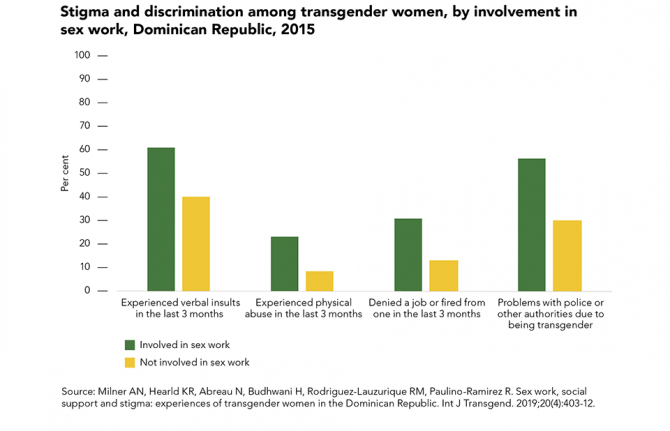 Transgender sex workers face frequent abuse
Transgender sex workers face frequent abuse

29 March 2022
 Many key populations avoid health services
Many key populations avoid health services

21 February 2022

Feature Story
UNDP: ‘AIDS and MDGs’ charting a way forward
22 September 2010
22 September 2010 22 September 2010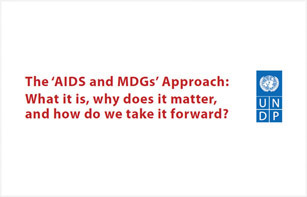
If the global HIV epidemic is to be curbed, links between HIV and reaching other Millennium Development Goals (MDGs) need to be explored, strengthened and leveraged. This is the key conclusion emerging from a new publication by the United Nations Development Programme (UNDP) released today at the UNAIDS hosted MDG Summit side event – AIDS plus MDGs: Delivering results towards our shared commitments.
The publication, The ‘AIDS and MDGs’ Approach: What is it, why does it matter and how do we take it forward?, highlights changes in the health and development landscape resulting in a need to re-think the relationship between HIV and the MDGs. This approach effectively addresses both the short- and long-term challenges and impacts of the HIV epidemic while promoting the attainment of wider health and development goals.
Drawing on recent research, programme experience, and country progress reports, the paper outlines three important elements: understanding how HIV and the other MDGs impact one another; exchanging programmatic lessons across HIV and the other MDGs; and, creating synergy and increasing cost-effectiveness through strategies that simultaneously address HIV and other MDGs.
“From the earliest days of the global AIDS epidemic, many have recognised that effective responses must combine biomedical and behavioural interventions with multi-sectoral strategies that address human rights and the underlying socio-economic conditions that shape vulnerability,” said Jeffrey O’Malley, Director of UNDP’s HIV/AIDS Practice.
“The MDG Summit signifies an exciting and historic opportunity to reaffirm commitments to address health and development together, and to exchange important lessons between the response to HIV and action to address other MDGs,” he said.
The report highlights case studies of how cross-MDG synergy can be promoted. For example, in Malawi’s Zomba district, the World Bank implemented a cash-transfer programme to encourage girls’ school attendance. A recent study showed a 60% decrease in HIV and other STI risk among participants. The girls were also more likely to stay in school, have a smaller age gap with male partners, and delay marriage.
The project demonstrates how leveraging the links between HIV and a range of other development issues can spur significant and accelerated progress towards multiple MDGs at once.
Related

Feature Story
MDGs Summit: Nigerian AIDS activist optimistic about success
21 September 2010
21 September 2010 21 September 2010
Lucy (standing) addresses the former First Lady of Nigeria Mrs. Turai Yar Adua during an advocacy visit by the Nigeria Task Team on prevention of mother-to-child transmission of HIV.
Lucy Attah has high hopes for this week’s Millennium Development Goals (MDGs) Summit. As a woman living with HIV and a gender activist from Nigeria, she believes the summit is an important opportunity to discuss issues of women’s equality and empowerment as well as achieving universal access to HIV services. Participating the summit means that she can share her experiences of helping to strengthen the AIDS response in her country.
As Executive Director of Women and Children of Hope (WCH), a Nigerian NGO, Ms Attah works to raise awareness about HIV. WCH also helps women living with the virus provide for their own material, physical and psychological well-being.
Ms Attah is member of a delegation of 13 representing networks of women living with HIV from all regions of the world. The delegation’ activities are part of a UNDP-supported global advocacy and capacity building initiative, which seeks to increase the visibility and voice of women living with HIV in the assessment of country progress toward achieving the MDGs and universal access. The initiative is also a component of the UNAIDS Agenda for Accelerated Country Action for Women, Girls, Gender Equality and HIV.
“Attending the summit is an opportunity for me to share the lessons and challenges of women’s empowerment and emancipation in our communities with the outside world.” says Ms Attah. “I will also use the lessons learned from success stories and best practices in other countries.”
WCH was formed by Ms Attah after testing positive for HIV in 1998. She was determined to address the prevailing stigma and discrimination which made her own life extremely difficult and which are still major barriers to the HIV response in the country.
Significant progress has been made in reducing HIV prevalence in Nigeria. However, with more than 3% of adults—an estimated 2.6 million—living with the virus, only South Africa has a higher total number of people living with HIV. Women often bear the brunt of the epidemic and represent more than half of people living with HIV, 1.4 million women.
There are many reasons for women’s increased vulnerability to HIV infection. Significant gender inequalities exist and women often find it difficult to protect themselves from HIV, particularly when they lack decision-making power. Levels of sexual violence are considered high and early marriage is common. Women tend to lack economic independence and those living in poverty often engage in sex work to make ends meet.
Despite these obstacles Ms Attah is optimistic about attaining the MDGs.
“We still have some way to go but we can do it if women become more involved in public policy and decision-making, more economically empowered and better educated," she said. “And if there is stronger legislation against the abuse of women’s rights and gender-based violence. Our goals are ambitious but we can get there.”

Feature Story
Red Ribbon Award 2010: Exceptional community AIDS leaders and activists recognized
22 July 2010
22 July 2010 22 July 2010 Ms Jan Beagle, UNAIDS Deputy Executive Director, Management and External Relations Branch, addressed the ceremony on behalf of the Executive Director. Credit: UNAIDS/Anna Rauchenberger
Ms Jan Beagle, UNAIDS Deputy Executive Director, Management and External Relations Branch, addressed the ceremony on behalf of the Executive Director. Credit: UNAIDS/Anna RauchenbergerA ceremony to celebrate the 25 winners of the 2010 Red Ribbon Award was held in Vienna 21 July, with a host of global AIDS leaders joining the award winners and some 250 guests. The award event, which included a formal gala dinner, took place during the XVIII International AIDS Conference. Mr Jeffrey O’Malley, Director of HIV/AIDS Practice at the United Nations Development Programme, (UNDP), filled the role of Master of Ceremonies and Ms Jan Beagle, UNAIDS Deputy Executive Director, Management and External Relations Branch, addressed the ceremony on behalf of the Executive Director.
Ms Beagle paid tribute to this year’s winners and the wider community who play a key role in making a difference.
“The AIDS response counts on community organizations. The Red Ribbon Award is one of the rare opportunities we have for celebrating those exceptional organizations and individuals," said Ms Beagle. "The twenty-five organizations we are celebrating tonight are making an essential contribution to reaching our vision: Zero! zero! zero!"
The winners, representing a broad range of community-based organizations from 17 countries, were recognized for their outstanding work in reducing the spread and impact of AIDS. The Red Ribbon Award, named after the vivid symbol of the global response to the epidemic, is a joint effort of the UNAIDS family and is hosted by UNDP.
Chosen for their remarkable efforts in innovation, creativity, impact, sustainability and leadership, each winner receives a cash award and international acknowledgement of their contribution to the strengthening of the AIDS response.
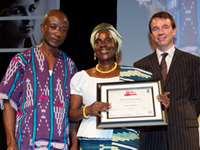 Red Ribbon Awards. Credit: UNAIDS/Anna Rauchenberger
Red Ribbon Awards. Credit: UNAIDS/Anna RauchenbergerSix special recognition winners were announced during the ceremony, one for each of five 2010 award categories and one extraordinary winner:
- Ensuring that people living with HIV receive treatment
Winner: Penitentiary Initiative, Ukraine - Supporting HIV prevention, treatment and care programmes for people who use drugs
Winner: Spin Plus, Tajikistan - Supporting human rights
Winner: Nikat, Ethiopia - Stopping violence against women and girls and promoting gender equality
Winner: POWA, Belize - Enhancing social support for those affected by HIV, including orphans and vulnerable children
Winner: Widows, orphans and people living with HIV (WOPHA), Sudan
An exceptional award was also given:
- AIDS and the Millennium Development Goals
Winner: NAIRN, Thailand
 Ms Elizabeth Matake, Special Envoy of the UN Secretary-General for AIDS in Africa. Credit: UNAIDS/Anna Rauchenberger
Ms Elizabeth Matake, Special Envoy of the UN Secretary-General for AIDS in Africa. Credit: UNAIDS/Anna RauchenbergerLeaders of the global AIDS response taking part in the ceremony included, Prof Michel Kazatchkine, Executive Director of the Global Fund to Fight AIDS, Tuberculosis and Malaria; Ms Elizabeth Mataka, Special Envoy of the UN Secretary-General for AIDS in Africa; Ms Svetlana Izambaeva, Russian activist and advocate, giving the key note address; and Ms Anandi Yuvaraj, Asia-Pacific Regional Coordinator of the International Community of Women Living with HIV/AIDS (ICW).
Out of 720 nominations from over 100 countries, the winners were selected by a Technical Review Committee of civil society representatives who are experts in the community response to HIV.
According to Jeffrey O’Malley, “These organizations clearly demonstrate that effective responses to the epidemic require the full participation of front-line, community-based groups. Community groups recognise that AIDS is one of many issues that are tied together. They understand that AIDS requires an exceptional response but they also understand that you need to link AIDS to broader issues of health, development and justice to be effective.”
Right Hand Content
Publications:
UNAIDS Outlook Report 2010 (pdf, 6 Mb)
UNAIDS Outcome Framework 2009-2011 (pdf, 388 Kb)
Related
 Keeping up the momentum in the global AIDS response
Keeping up the momentum in the global AIDS response

24 April 2019
 Malawi launches its health situation room
Malawi launches its health situation room

12 April 2019
 Learning lessons on evaluation
Learning lessons on evaluation

02 April 2019



